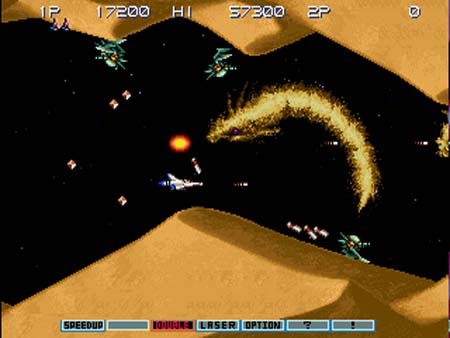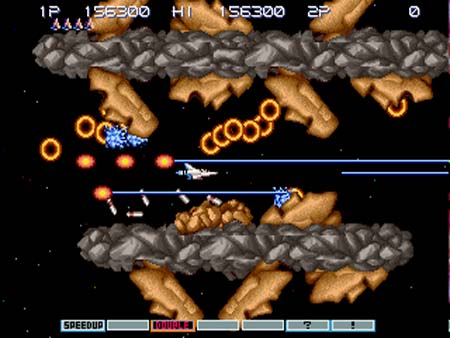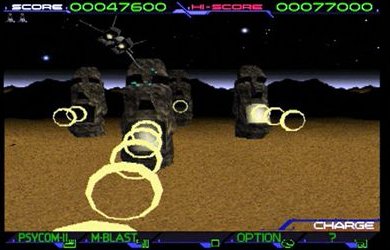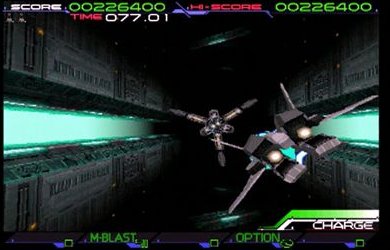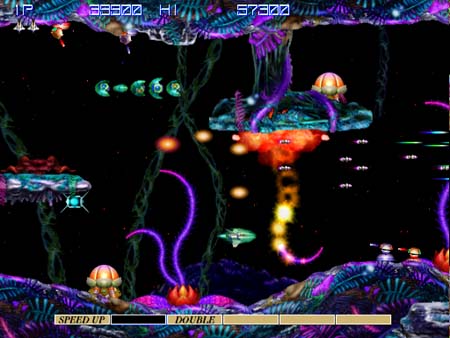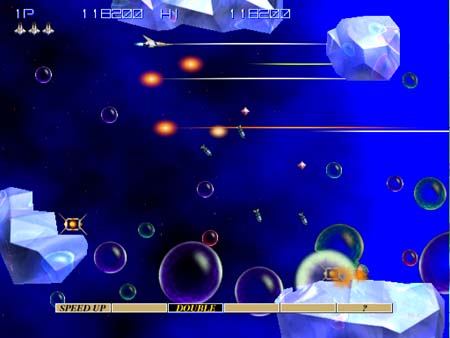Main
What's
New
Import Stores
Import Reviews
Import Cover Archive
Special Features
Games
The Top
100
Video Game Fiction
Wanted!
Acknowledgements
Forum
Links
Import Stores
Import Reviews
Import Cover Archive
Special Features
Games
The Top 100
Video Game Fiction
Wanted!
Acknowledgements
Forum
Links
No, not quite, even though a lot of reviews have claimed that Life Force for the NES, Gradius II for the Famicom and Gradius III for the SNES were direct ports of their respective arcade games. Some reviews of Gradius III & IV for the PlayStation 2 have claimed that the version of Gradius III on the disc is an emulation of the SNES game. In fact, one review I saw even claimed that Gradius IV was an emulation of an SNES game, which is 100% wrong - Gradius IV didn't hit arcades until 1998, shortly after the SNES was retired, and there was never a home version of the game until Gradius III & IV was released. That's a different story entirely, though.
For the most part, all those reviews are wrong.
None of those games are exact ports of the original arcade games. All three of them had changes made for their home releases. Obviously due to the hardware limitations of the systems they were ported to, they couldn't be graphically close the arcade originals (although the SNES version of Gradius III comes damned close), but the level structure and such could have remained fairly intact. Instead, Konami opted to change a lot of things around for the home releases, though... in fact, they changed so much from the arcade versions that it's worth it to own both the home and arcade versions due to the differences between them. Luckily it's possible to own the original arcade versions of each game thanks to the import only Gradius Deluxe Pack and Salamander Deluxe Pack Plus for the PlayStation and Saturn, and Gradius III & IV, which is available for the U.S. PlayStation 2. What I want to do here is discuss the differences between the arcade and home versions of all three games. I may not be able to cover all of the differences between the games, but I'll try to list the biggest ones.

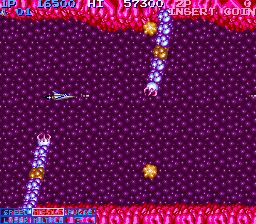
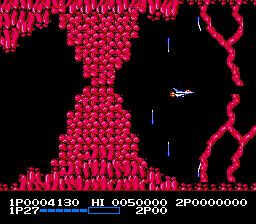
arcade version on the left, NES version on the right
Let's start with Life Force, which is probably the game the most players are familiar with. On the surface, the NES and arcade versions of the game look very similar. The further you progress in either game, the more differences appear. For example: the boss of Stage 3 - the Prominence stage- in the arcade game is a giant dragon, similar to the ones that chase you around in the first level of Gradius II. In the NES game, it's a giant dragon head, Cruiser Tetron, that spits fire at you. The NES game has two stages which are unique to that version of the game - stage 4 and stage 5. Stage 4 in the NES game is an upward-scrolling level that takes you through a nerve cluster, a speedup zone and a giant ribcage. Stage 5 is a horizontally-scrolling trip through an ancient temple, similar to the extra stage in the PC Engine CD-ROM version of Gradius II. The bosses to both of these stages are unique to the NES game as well. Stage 4's boss is Giga, a giant skull that attacks you with projectiles and it's own eyes. Stage 5's boss is Tutenkamenattack, which is a giant version of the Egyptian pharoah King Tutenkamen's death mask. The final boss of the game, Zelos' heart and soul, is protected by a giant snake that you have to destroy. This snake is not in the arcade game either.
In the arcade game, Stage 2's boss, the Intruder, is organic rather than mechanical like it is in all of the other games that it's in. Stage 4 is an upward-scrolling level that is actually more like the NES game's Stage 2. Stage 5 is a horizontally-scrolling flight through a field of kidney stones. None of the BGMs in the soundtrack to the NES game are exclusive to that version - they're actually a combination of BGMs from both the Salamander and Life Force arcade games. Truthfully, the NES game's stages resemble the Salamander arcade game more than the Life Force arcade game - and the reason for this may be because the original Famicom release was based on Salamander rather than Life Force. When the game was released for the NES, the name was changed to Life Force because Salamander had not been released in arcades in the U.S.


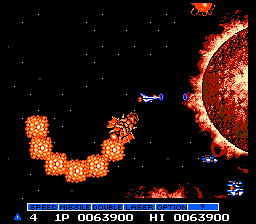
arcade version on the left, Famicom version on the right
Gradius II was never released in the U.S. in any form, yet those who have gotten their hands on both the Famicom version and any of the Deluxe Pack releases or the PC Engine CD may be slightly confused at the differences between them. The Famicom version has a few brand new bosses as well as some new stages that the arcade game didn't. For instance, Level 2 of the Famicom game looks remarkably similar to the arcade game, except for the addition of decorative skulls throughout the level. The reason for this becomes apparent at the end of the level - after fighting the second level boss from the arcade game, you're confronted with a new boss - Giga from the NES version of Life Force, who's much better looking now and has a brand-new laser attack.
In the first stage of the Famicom game, after flying past the miniature suns, you proceed to a prominence section which is much like Stage 3 of Life Force. In the arcade version, you encounter the Phoenix immediately after flying past the miniature suns. The giant spider mech that you fight in the next to last level of the Famicom game can actually be destroyed unlike the one in the arcade game, which must be avoided at all costs. For that matter, after avoiding the spider mech in the arcade game you fly directly into Gofer's lair to defeat him, but in the Famicom version you must negotiate an all new organic level before encountering Gofer. There are also a couple of brand new BGMs that are exclusive to the Famicom version.

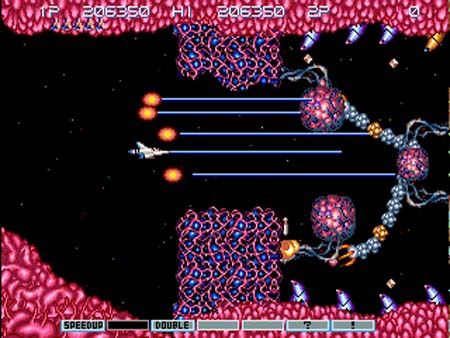
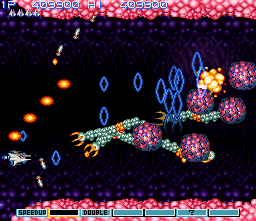
arcade version on the left, SNES version on the right
Graphically, Gradius III for the SNES came the closest to resembling the arcade game; however, it had the most changes from the arcade version. After you reach the middle of Stage 3, the game really starts diverging from its arcade counterpart. This is apparent before you actually start the game - the SNES version had an opening Vic Viper launch segment that was exclusive to that version, while the arcade game simply backtracked over the history of Gradius, much like Gradius II did before it. The Edit mode in the arcade version has a much more limited selection of weapons than the SNES game, and the Reduce shield seems to be a lot less effective in the arcade version.
A few changes that were made from the arcade game - in stage 1 of the arcade game, sand lions are roaming around, and the Antlion boss of stage one has little spiders that fly out to attack the Vic Viper. Both the lions and the spiders were cut from the SNES game. Halfway into Stage 3 of the arcade game, there's an additional segment that has you flying around rock outcroppings before going to the part where you blast your way through the sand that has the boulders buried in it. This was also cut from the SNES game. Stage 4 of the arcade game was cut completely from the SNES game - it's a 3-D stage where you must navigate the Vic Viper through a cavern, collecting powerups and trying not smash into the walls. There are no enemies at all in that stage. In the Moai stage, giant indestructible spinning Moais fly horizontally across the screen, depositing the regular Moais onto their perches. There are two Moai bosses - one is a flying Moai head that must be destroyed, the second is six giant Moai heads that spit out small Moais that inflate themselves as you shoot them, giving you little room to move. All of this was cut from the SNES Moai stage. The boss of the SNES Moai stage is two giant Moais that must be destroyed. They too spit out small Moais, but those don't inflate.
The organic level which made up the final stage of the SNES game appears much earlier in the arcade game, and the boss of that stage is exclusive to the arcade game. The fire stage of the arcade game was mostly unchanged on the SNES, except for two things - the small rocks can't be destroyed (they can in the SNES version), and there are two bosses at the end of the stage - a giant three headed dragon that was cut from the SNES game, and the double-headed dragon that was the boss of the stage in the SNES game. There's another arcade-exclusive stage, what I like to refer to as the "ice cube" stage. These Tetris-style pieces of crystal fly in from the right side of the screen and make new parts of the level - and if you're in the wrong place at the wrong time, you'll get boxed in completely. Then, at the end of that stage, right before fighting the boss, huge versions of the crystal cubes come out and aim right at the Vic Viper. These can be very hard to avoid.
The last stage of the arcade game was seperated into four stages in the SNES game - the boss stage, the Gauntlet, the confrontation with the Bacterion Emperor, and the escape. Some of the bosses in the arcade's boss stage come from Salamander - none of those bosses appeared in the SNES game. The Gauntlet features more traps than the SNES version does, including these rotating light platforms that must be manuevered through. The two giant blue four-legged spider mechs in the SNES game are exclusive to that version - in the arcade game, dozens of tiny versions of the Gradius II spider mech appear, and they're just as indestructible as the one in Gradius II. Finally, when you arrive at the Emperor's lair, you have to blast your way through four seperate regenerating cell walls - the gaps in between them have these organic blobs that keep crashing together. You have to fly in between these while making sure that the cell walls don't reform over the Vic Viper. When you finally fight the Emperor - who was ported almost identically to the SNES game, right down to his method of attack - he speaks to you. He does this in the SNES version as well, but in the arcade version he can be understood. He says: "I was born out of the greediness of mankind. While men exist, so will I." After he blows up, you have to escape through a speedup zone, which was moved backwards several stages and extended in the SNES game. The ending to the arcade game was also changed for the SNES version. On top of that, both version each have exclusive BGMs - for instance, the last stage of the SNES game has a unique piece of music that can only be found in that version.
UPDATE 03/03/03 - Here's some more info on the different versions of Life Force and Salamander from Hotaka.
About Life Force and Salamander: the Salamander Deluxe Pack Plus contains Salamander, Lifeforce and Salamander 2. This Life Force was made from Life Force for arcade JAPAN VERSION. Life Force for arcade exists in both WORLD and JAPAN version. The WORLD version was made from Salamander. The JAPAN version was made from Salamander and Life Force WORLD version. Konami addded a power up system (like the Gradius series) for the Japanese version. When Konami released the Japanese version, the advertisement said "This game is Salamander's world version!". A long time ago, Japanese Gradiusers realized the advertisement was untrue. When Konami released the Salamander Deluxe Pack Plus in '97, the advertisement read "This game is Salamander's world version!" again. Many people have realized since then that Life Force is Salamander's world version.
Salamander for the Famicom contains many element from Life Force JAPAN version. In Life Force for the NES you cannot equip the 3rd Multiple and it cannot display the endings that the Famicom version can.
For the most part, these are all of the changes I can think of off of the top of my head; as I uncover more, I will add them. Until then, here's a selection of pictures from the Gradius and Salamander arcade games:
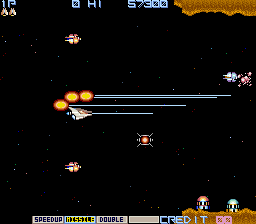
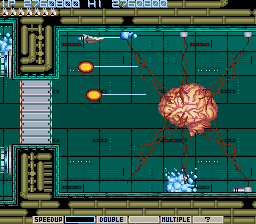
Salamander - 1986
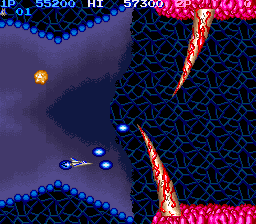
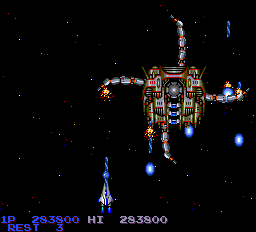
Life Force - 1987
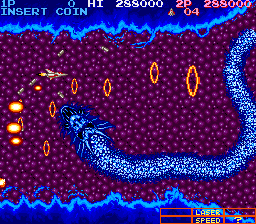
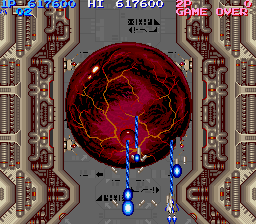
Gradius II - 1988
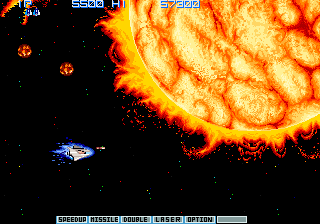

Gradius III - 1989
Salamander 2 - 1996
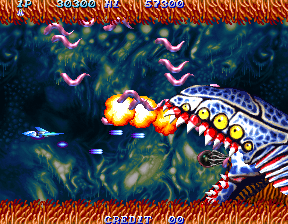
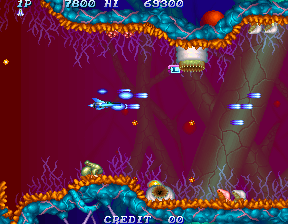
Solar Assault Gradius - 1997
Gradius IV - 1998
